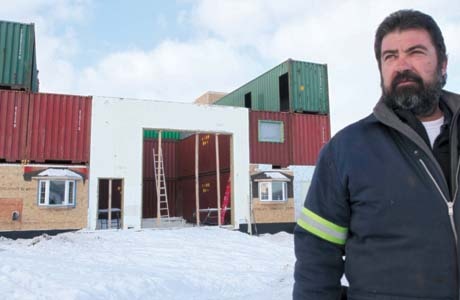RIMBEY — Sea can by sea can, Bill Glennon’s ingenious dream home is taking shape on a picturesque hill near Gull Lake.
Twenty-five shipping containers in place, half a dozen to go.
If all goes well, a crane will hoist those last few heavy steel containers three storeys and into place before Christmas. With a little cutting and welding, those rectangular boxes more usually stacked high on ship decks or dropped on to rail cars will become the frame for a master bedroom and two other bedrooms. On the same floor will be the kitchen. A deck will eventually be built above.
Glennon, 57, expects to be living in his remarkable home sometime next year. Not a moment too soon for his wife Roseann, who longs to get out of their chilly mobile home a stone’s throw away on their 20-acre farm property about eight km southeast of Rimbey. “She can’t wait,” he says with a grin.
This monument to inventiveness began taking shape about two years ago when Glennon moved to this rolling property with beautiful views in every direction about two years ago. The former Fort McMurray resident had been a carpenter, scaffolder and alarm technician before retiring to pursue his goal of creating his own self-sustainable Shangri-La.
“The whole project here isn’t just building a house out of sea cans,” he says, standing in part of what will be a 2,000-square-foot workshop, complete with painting booth and a garage fit for the biggest RV or truck.
“It’s about being off the grid. It’s about being self-sufficient.”
Sixteen solar panels are already in place and more will be mounted on the roof when he’s done. A small wind turbine built out of old coffee cans sits twirling in one corner. It’s just a test model for a version he plans to build out of oil barrels. Between solar and wind, he expects to generate about four kilowatts of power, more than enough to meet his electricity needs.
The Glennons have been growing some of their own food and raising a few chickens. The bowling ball-size potatoes and the one chicken they’ve cooked so far were delicious.
“We’d like to be able to get most food from the property itself,” he adds. “We’re planning on getting a few goats, maybe a few more chickens and just keep going.”
Excess water from the home will travel through a sump pump to a pond he hopes to stock with trout or some other game fish. He already has his fish culture licence.
In the basement of his home, he shows off the complicated-looking system of pipes, meters and tubing that will form a highly efficient system to provide hot water for washing and showers and an in-floor heating system, which will provide most of the heat needed to keep rooms comfortable. High-efficiency wood stoves will do the rest. Root and wine cellars will also be located in the basement.
Above the workshop will be daughter Kala’s room, and games, TV and sewing rooms.
The project has become a family affair. Kala built the stairs to the upper storeys, and various brothers and sisters of Bill’s have stopped by to help for a few days or weeks. Even his 85-year-old father got in on the construction.
Kala, who aspires to be a nurse, said her friends aren’t always sure what to make of the project. But she is enjoying the experience.
“It’s unique. I’m glad to be a part of it.”
Helping hands have also come from outside the family. An electrician friend, Wade Rankin, has donated all of his time just because he likes what the Glennons are trying to do. Other volunteers stop from time to time to boost the workforce.
Many others have come by just to gawk. Glennon figures two to three people a week stop by to see what he is doing. Some just happen to notice it when they are driving by, others have heard of it through the grapevine or seen his website at www.glennonseacanhome.ca, which offers a blow-by-blow description of construction along with dozens of photos. A YouTube video he created on the house even ended up on Pakistani TV.
Glennon has taken to keeping a guest book. “Amazing” and “impressive” pop up frequently in comments.
Since construction started with the first excavations in September 2009, Glennon has put in eight- to 12-hour days, seven days a week.
“I’d love to be done,” he says when asked if he ever gets tired of the routine.
But while he expects to be living in the home sometime next year, he admits he will probably never really be finished.
“When I’m done, it’s done. There will always be something to do.”
pcowley@www.reddeeradvocate.com
